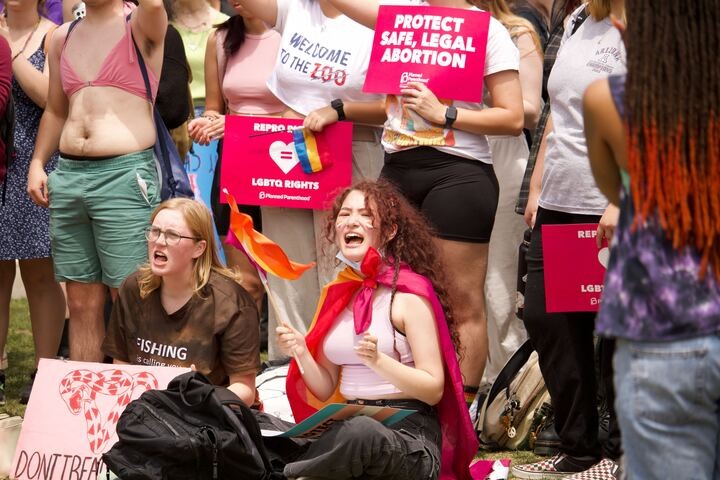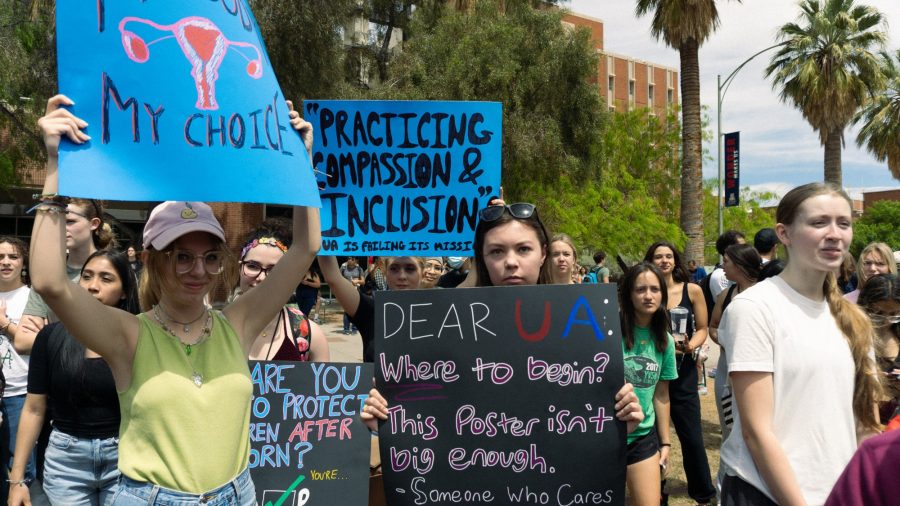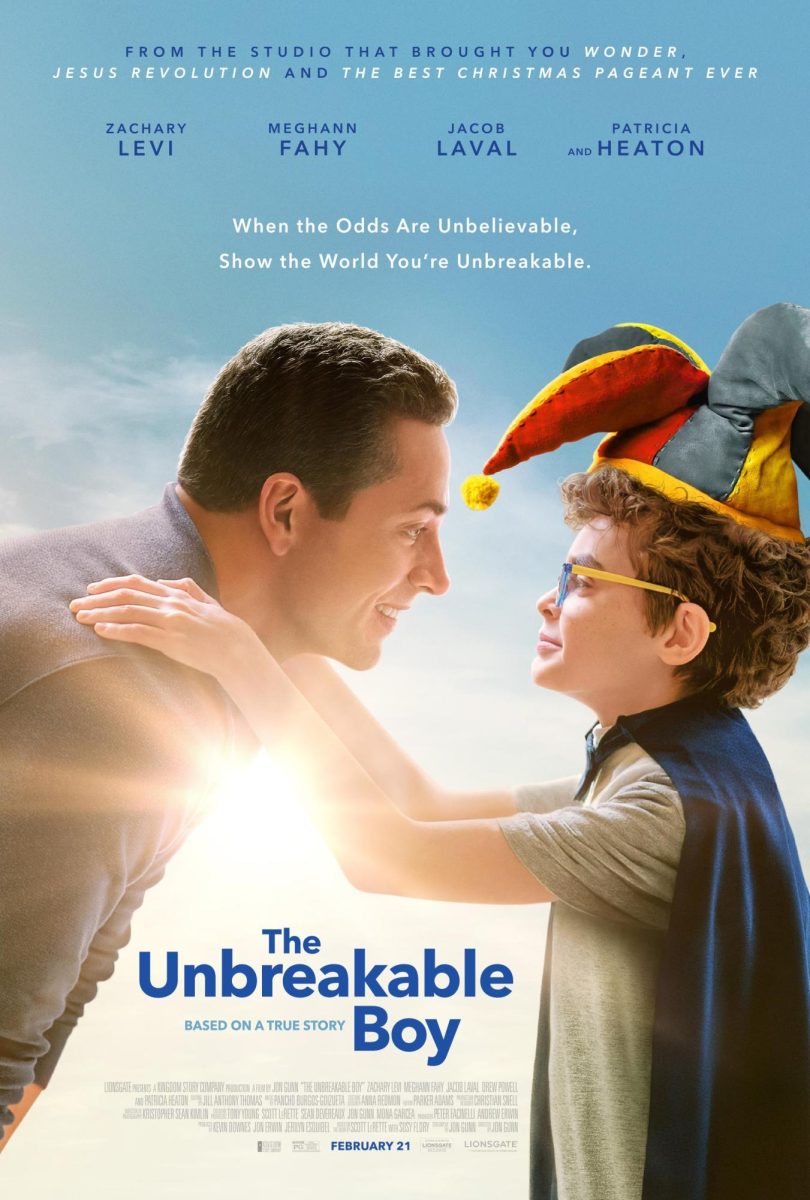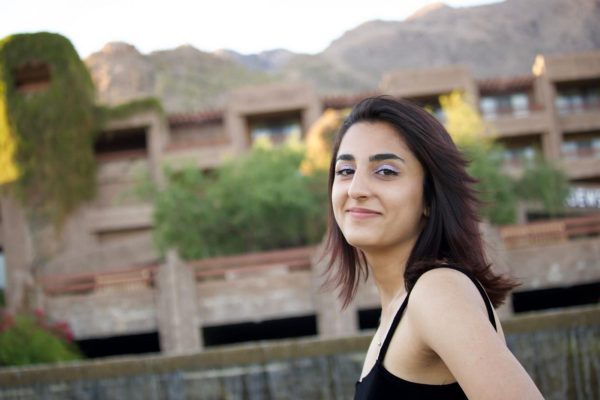This month, the student-run College Republicans club invited and sponsored a two-day demonstration by the Center for Bio-Ethical Reform on the University of Arizona Mall.
Enclosed by a small metal fence, the group of older men and women proudly lingered underneath their various large billboards — each with a different image and description. One sign displayed a photo of a bruised child next to an embryo reading “Should the government prohibit child abuse?” Another claimed their graphic images of bloody, dismembered fetuses saved the life of a precious baby.
As students gathered, demonstrators became swallowed by a sea of hot pink Planned Parenthood signs — the only barrier between them being the fence law enforcement had set up hours prior.
Inside the fence, an older woman began filming me with her Samsung upon request for comment. Another man told me he didn’t know what College Republicans were, or who was sponsoring the demonstration — he was just here to volunteer.
Custom for anyone wishing to schedule an event here on campus, the scheduled demonstration was required to be approved by the Arizona Student Unions scheduling office.
Since College Republicans is a student club, the group had to also go through our student government’s guidelines. According to the Associated Students of the University of Arizona’s student organization handbook, if a club’s proposed event seems to be larger than normal, the organization may be asked to present at a Campus Use Committee meeting.
Even as students walked away, the large photo displays of swastikas, lynchings and other genocides remained clear, unharmonious with the rows of palm trees lining the UA campus. It was then I found myself wondering how our administration defines an event as larger than normal and how hate symbols must have looked displayed at a Campus Use Committee meeting.
When asked about the principles of hosting a demonstration like this, Arizona Student Unions event planner Cheryl Plummer was able to explain further on the second day of the demonstration.
“They followed everything to the letter,” Plummer said. “We have followed everything to the letter because we don’t want to be told ‘you denied something.’ We do not deny. We cannot. We have to allow it.”
Following the two-day long disruption on the UA Mall, students may question the tolerance of the administration, all just because rules were followed by the letter. Does the disturbing and hateful content shown on this campus become voided in the presence of paperwork and the pursuit to allow, to not deny?
It seems as if all answers point to yes.
“Students have the option to walk around or go the other way. This is an open venue. This is an open space,” Plummer said. “Students have the option to walk through the food court. We can’t regulate what they have because then we’re impeding their rights. It would be like me impeding you. You wouldn’t want that, you’d sue me.”
Likely, a potential lawsuit is not the topic on most students’ minds. A campus climate where we don’t have to be advised to take another route to avoid a slew of slurs and graphic genocide seems more than sufficient.
The truth is, we cannot go around the blatant hate both displayed and tolerated on our campus. We can’t take the food court shortcut, as much as administration might want us to. When starting a conversation surrounding the rules and regulations of free speech on campus, the only way is through.

The anti-abortion group spent the two days they were here engaging in what they referred to as respectful dialogue with students. One anti-abortionist used the n-word multiple times while simultaneously claiming he was not racist. Students — Black and white — explained the origin of the word and its role within America’s past. More likely than not, this history lesson wasn’t a planned part of their Wednesday walk to class.
Brunhi Salvant, a sophomore here at the UA, was among the students who spoke to the racist demonstrator.
“He was like ‘Why do Black people get to call themselves the n-word like that but I can’t?’’’ Salvant said, referring to the same man.
Unfortunately, Salvant was one of many students disturbed by the demonstrators. Various victims of past massacres were exploited on display by the Center for Bio-Ethical Reform, in what seemed to me to be a clear attempt to create some sort of disturbing shock value. The posters of lynching, the Holocaust and many more graphic images were placed with intent to make a distorted comparison of abortion to genocide.
It’s difficult to imagine images of swastikas and other hate symbols being given the okay by the administration whose title falls under “event planning.” It’s equally as difficult to imagine photos of lynchings being given the okay for a school with 3.78% Black students and 9.4% Jewish undergrad students.
When I spoke with administration during the demonstration, I was continually reminded of the importance of protecting the anti-abortion group’s rights. I found myself thinking of my fellow women, my Black friends, my Jewish friends and asked myself who was protecting theirs.
“Putting these pictures here, that triggers a lot of people,” Salvant said. “There’s people’s histories up there. The lynching of Black people, the Holocaust. I don’t want to be in college and I’m walking to class and I see one of my ancestors hanging from a tree, which I didn’t ask for.”
Is it possible to preserve free speech without the distress of students?
— Olivia Krupp, Opinions Editor
If you ask the administration, the answer is foggy. Multiple requests for comment from both the Dean of Students Office, College Republicans club and President Dr. Robert C. Robbins were left unanswered. Time and time again this year, the university administration has let its student body down.
The past week was another example of their failure to put student safety and education first. We are a public university with an open campus where “free speech” and First Amendment rights are granted. However, when that free speech is exercised at the expense of another’s well being, it should not be acceptable, especially by those who make a promise to their student body.
A similar instance occurred in 2016 on DePaul University’s campus when College Republicans sponsored a right-winged presenter. Students and community organizers in opposition were left to defend themselves with little university back-up, much like we were. One counter-protestor in particular led the takedown of this hateful speech.
“Let me be perfectly clear, I do not apologize for my actions on DePaul’s campus,” he said, as quoted by the school’s independent student newspaper, The DePaulia. “I don’t apologize for refusing to allow a racist, bigot to spew his hatred on DePaul’s campus. I don’t apologize for shutting the event down. I don’t apologize.”
Among those who were terrorized on our campus were Jewish students. Sophomore Daniel Wittenberg, president of J Street U of A, approached me with frustration.
“I think this is a hateful and inflammatory display and I think it’s pretty clear the intent here is to upset as many people as possible,” he said. “[Nearly] 10% of U of A’s campus is Jewish, so 10% of our campus is going to be directly affected by that imagery of the Holocaust.”
The Center for Bio-Ethical Reform’s comparison of abortion to genocide was a complete fallacy. Comparing abortion to genocide is claiming it to be “intentionally destroying part or all of a national, ethnic, racial, or religious group, by killing people or by other methods,” according to the Cambridge University Dictionary.
In reality, abortion is not carried out to target any minority group nor is it done with the intention of destroying the fetus population. Still, many of the anti-abortionists on campus that day claimed they were not scaring anyone and that “comparable does not mean identical.” But comparison is not relevant to this serious matter in the first place.
University administration also failed to support Jewish students with any comment of solidarity.
Freshman Andreana Finnegan, a fiery pro-choice student, watched as anti-abortionists constructed their display Thursday morning.
“There was no education happening on this campus yesterday, nor is it happening today. I don’t know how anyone is meant to get an education in this environment, let alone feel safe,” Finnegan said. “I used to bring my little sister on this campus. I will never bring her again.”
Not only was the student body affected, but many of those in the greater Tucson community were shaken as well. Surely families will not want to take chances walking on campus, risking the danger of running into another protest so severe. Clearly this was not a matter of simply walking in another direction as Plummer described; something so haunting is unavoidable and students should not have to worry about rushing in the opposite direction in the first place.
Not only were we not warned of the disturbance ahead of time, but we were given a disappointing response (or lack thereof). When something this horrifying is presented on our campus, the administration cannot expect peace. Hateful protestors cannot expect “respectful dialogue.”
Many students were angry and came ready to amplify their voices against hatred. They stood up for each other, empowered those who were exploited, while also confronting the College Republicans president Alton Zhang and the Center for Bio-Ethical Reform face-to-face.
— Noor Haghighi, Opinions Writer
No matter how closely policy is followed to the letter, the damage of hateful demonstrations have lasting effects on our campus. School is meant to be a comfortable place — not a place where individuals are bullied and groups of people are antagonized.
If a conversation regarding regulations of hate speech on campus doesn’t start now, then when?
If not us, then who?
Follow the Daily Wildcat on Twitter










